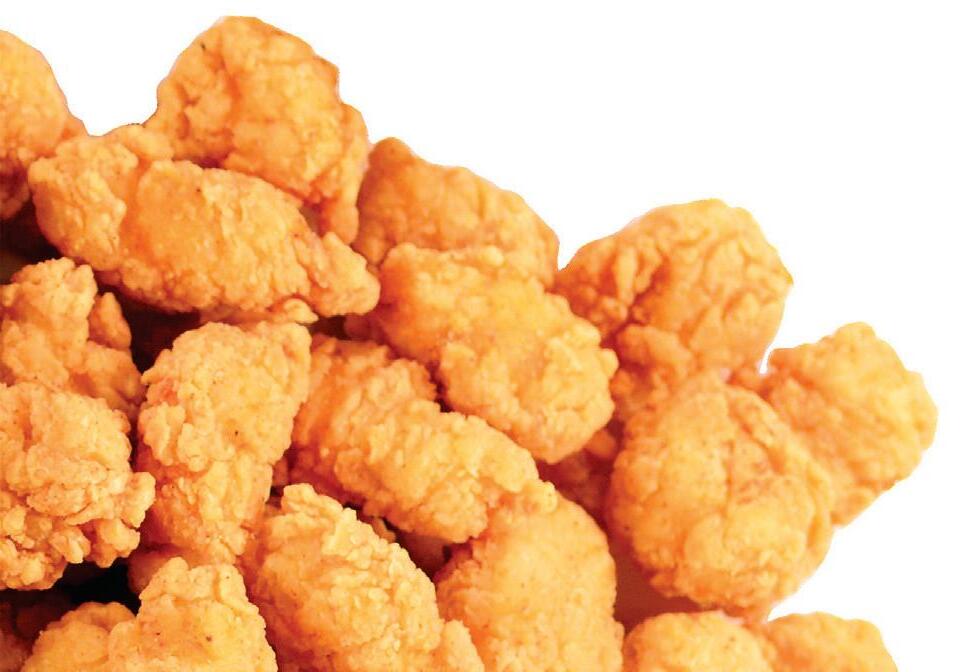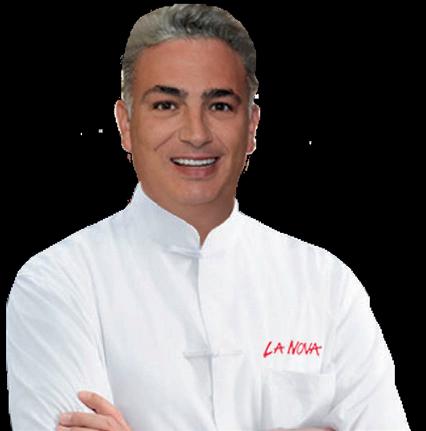














Bellissimo makes a lasting first impression with its easy-to-cook and quick-to-serve Chicken Wings. This profitable starter can be fried or oven baked resulting in a deliciously crunchy coating. Bellissimo Chicken Wings set the table to make sure your customers keep coming back.
Bellissimo offers a full line of par-fried and fully-cooked chicken items. Bellissimo distributors are the exclusive source for Bellissimo Chicken Wings. Visit Bellissimo.com to contact a representative and request samples and pricing.

IT FEELS GOOD KNOWING ONE INGREDIENT ISN’T DEBATABLE. JUST GO WITH THE BEST. END OF DISCUSSION.

What’s your declaration of independence?


Grande is championing operators who have an independent spirit and shared passion for excellence. By providing the finest all natural, authentic Italian cheeses, along with an unwavering commitment to quality, we’ll continue to advocate for independents and their love of the craft.



















According to architect Brian Laubenthal, your amazing pizza and staff will look even better in a restaurant designed to give patrons a memorable experience.

pmq.com/restaurant-design
A partnership between Piestro and 800 Degrees Pizza, founded in California, will bring a new version of the pizza chain’s brand to high-traffic locations.
pmq.com/piestro-800-degrees-pizza
We Asked Indiana Pizza Club Founder: “Hoosier Your Favorite Pizza Joint?”

In a state where pizzeria owners don’t like to brag about themselves, members of this unique club act as spokespeople for a thriving pizza scene.
pmq.com/indiana-pizza-club
Through October 31, Margherita is offering foodservice operators the chance to join the U.S. Pizza Team as they compete in the World Pizza Championship. pmq.com/margherita-sweepstakes
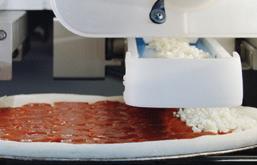
Picnic is gearing up to offer its innovative robotics-asa-service (RaaS) system to pizzerias through a monthly subscription model with no up-front costs.
pmq.com/picnic-pizza-robots
A study by the NPD Group, released in mid-August, found that distributors shipped far more plant-based meats to pizzerias in the second quarter of 2021.


pmq.com/plant-based-proteins-boom
Inc.
662-234-5481
Volume 25, Issue 8
October 2021
ISSN 1937-5263
PUBLISHER
Steve Green, sg@pmq.com ext. 123
CO-PUBLISHER
Linda Green, linda.pmq@gmail.com ext. 121
EDITOR IN CHIEF
Rick Hynum, rick@pmq.com
ART DIRECTOR
Eric Summers, eric@pmq.com
SENIOR COPY EDITOR
Tracy Morin, tracy@pmq.com

IT DIRECTOR
Cory Coward, cory@pmq.com ext. 133
DIRECTOR OF RESEARCH
Blake Harris, blake@pmq.com ext. 136
TEST CHEF/USPT COORDINATOR
Brian Hernandez, brian@pmq.com ext. 129
REPORTER
Chris Green, chris@pmq.com
FOOD PHOTOGRAPHER
David Fischer, david@pmq.com
CHIEF FINANCIAL OFFICER
Shawn Brown, shawn@pmq.com
ADVERTISING
SALES DIRECTOR
Linda Green, linda.pmq@gmail.com ext. 121
SENIOR ACCOUNT EXECUTIVE
Tom Boyles, tom@pmq.com ext. 122
SALES ASSISTANT
Brandy Pinion, brandy@pmq.com ext. 127
PMQ INTERNATIONAL
PMQ CHINA
Yvonne Liu, yvonne@pmq.com
PMQ RUSSIA
Vladimir Davydov, vladimir@pmq.com
PMQ PIZZA MAGAZINE 605 Edison St. • Oxford, MS 38655 662.234.5481 • 662.234.0665 Fax
PMQ Pizza Magazine (ISSN #1937-5263) is published 10 times per year.
Cost of U.S. subscription is $25 per year. International $35. Periodical postage pricing paid at Oxford, MS. Additional mailing offices at Bolingbrook, IL. Postmaster: Send address changes to: PMQ Pizza Magazine, PO Box 9, Cedar Rapids, IA 52406-9953.
Opinions expressed by the editors and contributing writers are strictly their own, and are not necessarily those of the advertisers. All rights reserved. No portion of PMQ may be reproduced in whole or part without written consent.

October 3-5
Fast Casual Executive Summit
Now in its 16th year, this event offers top-level restaurant executives a chance to get together in a relaxed setting to learn from each other. The roster of keynote speakers will include Tom Krouse, president and CEO of Donatos; Mandy Shaw, CEO of Blaze Pizza; and Andy Hooper, president of &pizza.

Learn more at fastcasualsummit.com.
October 22-26
HostMilano International Hospitality Exposition
HostMilano returns as a live, in-person event in Milan. With more than 1,000 exhibitors from 40 countries already signed up and 800plus events for restaurant and foodservice operators, this one is a worldwide can’t-miss!

October: National Pizza Month

It’s time to celebrate the world’s greatest food with pizza specials, contests and events! Develop a different specialty pizza for every week in October. Create short, lighthearted videos for TikTok. Set up an “Instagrammable” section in your restaurant where customers can snap and post selfies to win free pizza. Get creative and have fun with it!
October 9
International Beer and Pizza Day
Beer is comfort food in liquid form, and your customers need a little extra comfort in this challenging year. Partner with a local brewer to develop seasonal beer-and-pizza pairings and use social media and signage to cross-promote the event.
October 11
National Sausage Pizza Day
Showcase your housemade sausage or your favorite sausage brand with a specialty pie bursting with meaty flavor. Roll out a new pizza featuring plant-based sausage for the vegan and flexitarian crowd—it could be your next featured menu item!
October 17
National Pasta Day
Proud of your pastas? Take advantage of this food holiday (doesn’t pasta really deserve its own month?) to show them off with special promotions and pricing. Make sure to post mouthwatering photos and videos featuring your best dishes on social media.
2 p.m. (CT), October 5
PMQ Live Update: Lee Hunzinger
Thunderbird Pies started out as a virtual brand specializing in Detroitstyle pizzas and now has a brick-andmortar location in Fort Worth, Texas. Lee Hunzinger of PILF Restaurant Group (which owns Thunderbird, Zoli’s Pizza and Cane Rosso) talks about how ghost kitchens can create ancillary revenue without changing your existing menu or concept. Join us on Facebook Live!
Here’s a look at upcoming restaurant and foodservice events you won’t want to miss in October, plus some special food and beverage holidays and PMQ’s latest live interviews with top pizza professionals!




The world of Ho.Re.Ca. (hotels, restaurants and cafes) will come together for a single blockbuster event at HostMilano, to be held from October 22 through October 26 in Milan, Italy. The show will feature everything from the art of baking and professional catering to coffee machines, tableware technology, ice cream, pastries and confectioneries.
Now in its 42nd edition, HostMilano is a true global equipment hub and will feature all key players in the world of professional hospitality. According to ExportPlanning, the first quarter of 2021 showed strong acceleration in the professional catering segment, up 22.8% in euro value compared to the first quarter of the previous year and 23% compared to the same quarter in 2019. The tableware segment has also shown positive growth of 11.1% over the first quarter of 2020 and a 5.7% uptick from 2019.
Similar trends were recorded for Italian exports during the first three months of the year. For example, the Made in Italy segment (linked to professional catering) saw a strong recovery of 20.8%, while the tableware segment jumped by 11%, compared to a 6.2% decline in the first quarter of 2020.

Meanwhile, according to the International Monetary Fund’s World Economic Outlook, forecasts indicate a return to accelerated rates of development for the period of 2021 through 2024, particularly in the global trade. The most dynamic segments will once again be professional catering (with an average annual growth of 6.9% in the 2021-2024 period) and those related to the coffee machine vending segment (7% average annual growth). With respect to Italian exports, the positive trends will encompass all sectors, particularly in the areas of coffee machine vending and bakery/confectionery.
In keeping with its longstanding tradition, the 2021 edition of HostMilano promises to be the ideal marketplace to address all of the most important realities of professional hospitality, with 1,100 exhibitors already committed to attend. They will come from 40 different countries, including Germany, France, Spain, the United States, Portugal, Holland, Greece and the United Kingdom. Eighty-nine percent of the event will focus on professional catering (38%), coffee machine vending (33%) and tableware technology (18%).
This year’s HostMilano event will be held in conjunction with TUTTOFood in order to exploit synergies between similar and complementary sectors. It will also feature the SMART Label—Host Innovation Awards, with more than 79 candidates from the foodservice equipment and vending segments. To learn more, visit host.fieramilano.it.

HostMilano is a true global equipment hub and will feature all key players in the world of professional hospitality.



clownhair: We have a delivery/carryout pizzeria. Since COVID19 hit, our sales have doubled, going from $3,000 on Fridays to $6,000. I’m looking for some advice on how to handle rushes. With our setup, an order comes in and gets printed at two stations: the make line (station 1) and the cut table (station 2). At station 1, we have one person making the pizzas and a second person assisting with accessory items, like subs, salads and stuffed-crust pizzas. At station 2, we have one person pulling most of the items out of the ovens and a second person finishing the items, such as adding lettuce, tomato and mayo to the subs, while also pulling items out of the oven as needed. But we are running way behind on fulfilling orders. It’s just chaos. How can we get a handle on this?
UncleNicksPizza: When I ran a store for one of the national chains, we routinely had $5,000 to $6,000 nights, mostly between 4:30 and 7:30 p.m. During this time, we had three team members up front, two dedicated to the phones and one working counter service. We had two team members slapping out dough, one saucing the skins, and two or three working the topping station in assembly-line fashion. We had two people on

Now that sales have doubled for this DELCO pizzeria, the owner seeks advice for staffing his kitchen during rush periods.
the oven—one primarily handling pizza and the other assisting in packaging side items. We had one expediter/router for deliveries and one runner bringing items called for by the line. With all those people, it got pretty hectic, but it was doable.
brad_randall: I just did some consulting for a new operation that had four stations—pizza maker, grill, fryer and cutter. A manager stands at the printer and expos the tickets, coordinating and timing everyone so the appetizers come out together first and the entrees come out together second. On the busier nights, they schedule a second or even a third person on the make line, with a “captain” keeping the speed rack full of pizza skins and saucing and cheesing the pies, then passing them on down to be topped. That captain makes sure every pizza/salad gets made and that different styles are properly timed. Busier nights also require an additional person to make appetizers and desserts and assist on the fryer. Also, an expo was added to the waitstaff to help the cutter make sure everything gets made, plated properly and sent out to the correct server.
Because if your phones and web ordering are down, you may as well send everyone home. We become your phone company and provide a backup Internet connection

Increase revenue and lower cost
• No Busy Signals
• Call Recording
• Call Queuing / Auto-Answering
• Multiple (random) start-of-call upsell messages




• On-hold music/message loops
• Detailed reports—hold times, lost calls etc
• Callerid delivered to POS system
• Auto-attendants—”If you have arrived for curbside pickup press one”
• When your Internet fails our cellular backup router keeps your phones, credit card processing and web orders all working.
• The backup kicks in automatically in seconds. So quickly you will not even drop calls in progress when your primary Internet goes down!
• The same router can be used to create chainwide virtual private network to connect your locations.
• SD-WAN LTE/LTE-A (4G/5G) modems.
Ask us how we can make your life easier and improve your customer ’s experience during these difficult times. Our rapid response support team averaged almost 500 custom changes per week in April-June. As “the rules” changed for our clients, we updated messaging and call flow to minimize impact, maximize revenue. Let PizzaCloud do the same for your stores.
Maintain control, and get the calls off the front counters. For a small chain all you need is a large office at one location. Cut labor hours up to 50% and/or shift labor to lower cost regions while increasing average ticket . Eliminate the constantly ringing phones at the front counters! Tight integration allows calls to overflow to stores, so you can choose when to staff the call center.
The same tight integration, same detailed reports and call recordings in your hands, same ability to overflow back to the stores, but you let some one else hire and manage the staff. We can provide this service to you or work with your existing call center provider.
If you have any interest in call centers call us to discuss options or visit www.pizzacloud.net to register for a webinar.


As kids in Boston, Jesse and Joshua Jacobs grew up on a macrobiotic diet—brown rice, lentils, tofu, seaweed and the like. As the owners of Joyride Pizza, they opened their first two restaurants on the same day in San Francisco without a chunk of tofu in sight. Joyride Pizza is all about Detroit-style squares, featuring as many ingredients from Sonoma County as possible—we’re talking meats like pepperoni, chicken and bacon, plus organic Yecora Rojo wheat, which yields a bubbly, delicate dough with naturally sweet and malty notes. Jesse has never forgotten the day he chomped into his first real pizza at a birthday party in the 7th grade and discovered true gustatory joy. It was a welcome departure from his mom’s homemade pies featuring a quinoa cracker crust, sauce made from beets, and crumbled, fried tofu substituted for mozzarella. Stuck at home during the 2020 COVID-19 lockdown, Jesse, who also owns Samovar Tea with his brother, started tinkering around with sourdough starters in his home kitchen and decided to get into the pizza business. “Homemade pizza has brought so much joy to my family over the past year that my brother and I ultimately decided to go all in and develop the best Detroit-style pizza we could imagine,” Jesse says. Read the Jacob brothers’ full story at PMQ.com/joyride-pizza.

The competition for best-pizza honors is stiff in Fairport, New York, but Perinton Pizza and Pizza Chef settled a different question—who has the better softball team—on Labor Day, and Pizza Chef won the pennant. After Perinton Pizza owner Kevin Peters issued a fundraising softball challenge to his friendly rival on social media on August 15, Pizza Chef owners Derek and Amy Averell quickly reached for their bats. “Pizza Chef is the best at everything,” Amy told Spectrum News 1, with a laugh, before the game started. “We got our players out there, and we are going to take them down.” She wasn’t just talking smack—Pizza Chef won the game 26-7. Each pizzeria picked a favorite nonprofit and pledged to donate all funds raised to the winner’s favorite. The game racked up $715 for Golisano Children’s Hospital in Rochester, New York. Peters didn’t mind the loss and hopes to make the game a Labor Day tradition. “It’s nice to take a day off, after what we’ve been through for the past year and a half, and not have to worry about flipping pizzas today, but instead get out and have some fun on the diamond,” he said.


Mike’s Hot Honey started out of a pizzeria in Brooklyn 11 years ago, creating a whole new category of pizza topping that has been called a ‘game changer’ by pizza fans and spawned best-selling menu items for pizzerias nationwide. Request a sample today to see what all the buzz is about: www.mikeshothoney.com/sample




Marc Schechter and Danny Stoller, owners of Square Pie Guys in San Francisco and Oakland, wanted to make this year’s National Pepperoni Day more than an excuse to sell a few extra pepperoni pizzas. So they rounded up a posse—a Pepperoni Posse, to be specific—comprised of more than a dozen Bay Area pizzerias committed to feeding people in need. All of the participating pizzerias donated a portion of the day’s sales on Monday, September 20, to their favorite nonprofits focused on food insecurity. “We wanted to do something outside of the norm,” Schechter said. “Typically, national food holidays are always kind of ‘throwaway’ events. Maybe we’ll run a particular discount or make a funny post on social media, but that’s as far as we go.” To make the day more meaningful, Square Pie Guys enlisted area pizza shops like Pizzeria Delfina, Fiorella, Pizza Leah, Cellarmaker House of Pizza and others to join in the promotion. The initiative required “lots of emails, texts and direct messages on Instagram,” Schechter said. “It was a fun exercise indeed.” Read more about Square Pie Guys at PMQ.com/square-pie-guys.

Adam Martinez, a culinary arts teacher at Odem High School in Odem, Texas, can’t back down from a double-dog dare. So when his students dared him to open a pizza restaurant, he did exactly that. He even gave it a dad-joke name: Updog Pizza. “I want customers, when they walk in, to say, ‘It smells like up-dog in here,’ and we have to respond, ‘What’s up, dog?’” Martinez told KRIS-TV. The pizza shop, located near the high school, offers real-world restaurant work experience for current students and graduates alike. Students in the school’s Social Media Marketing class are also contributing to the business. Updog Pizza offers a limited number of Detroit-style and traditional round pies for pickup only. Many of the pizza names are inspired by the school’s past and present coaches and athletes, including the Coach K (pepperoni, Italian sausage, ham, bacon, red pepper flakes and Mike’s Hot Honey) and the Moose (pepperoni, bacon, Italian sausage and ham). “Everything I’m going to bring is going to revolve around building relationships with the students,” Martinez said in the KRIS-TV interview. “Some people might think we’re crazy, but I think we’re fun.”


WestRock takes food safety as seriously as you do. Our pizza box liners, medium and finished products are routinely tested by independent, certified laboratories to ensure that only safe materials go inside. Final packaging meets FDA requirements for food contact.


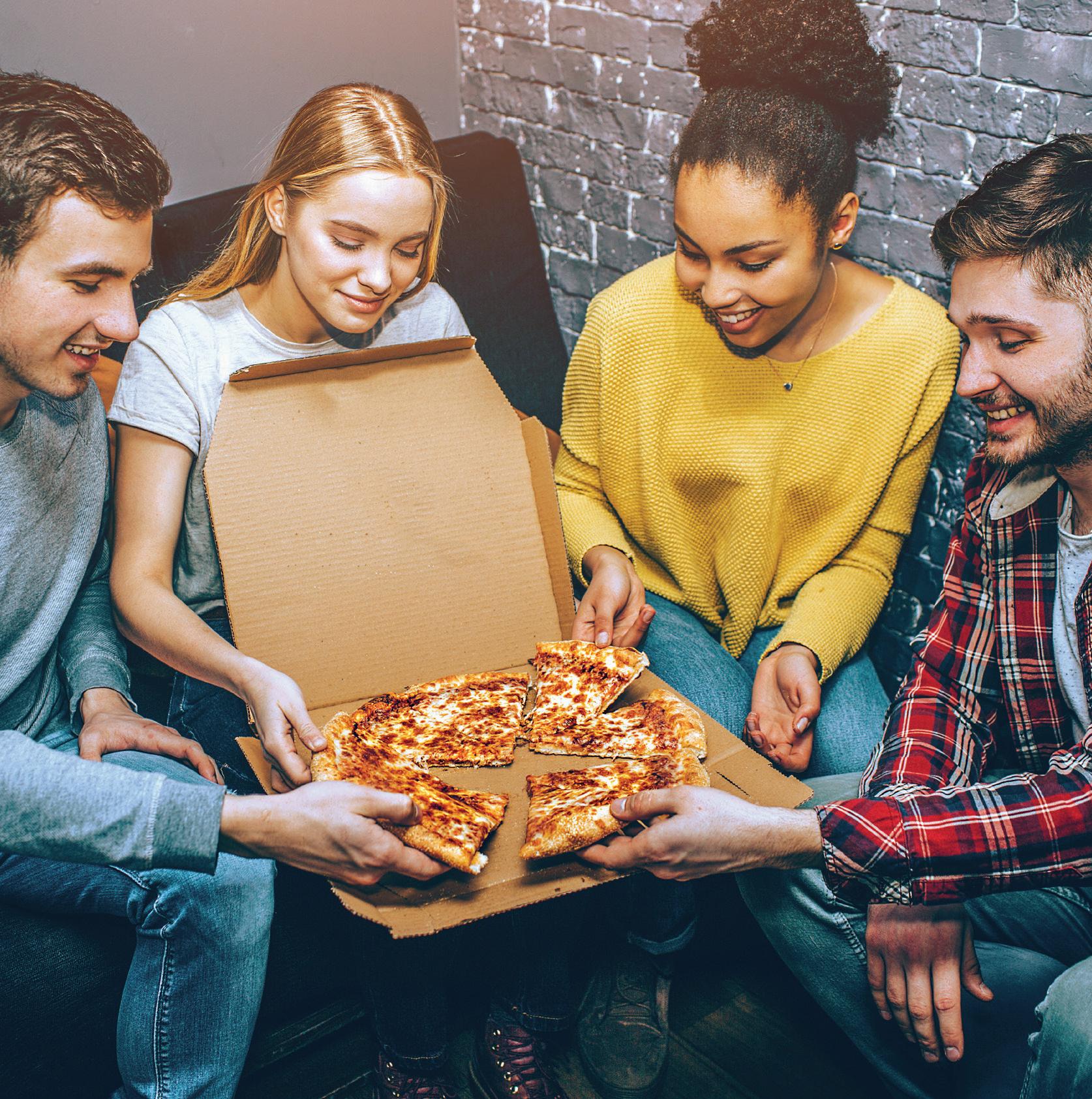
westrock.com/pizza pizzaboxes@westrock.com

They say a picture is worth a thousand words, which begs the question: How many words is a video worth? Well, more than my editor will allow in this article, but I’ll give it my best shot. The typical American pizzeria has changed very little over the years. Of course, pizzerias have conceived of and implemented new tools and techniques along the way, but the basic building blocks have been the same: ovens, flour, cheese, sauce and satisfied customers. There has been one notable change for modern pizzerias: marketing with new media.

First came newspapers, then radio, TV, and finally the internet. Whereas we used to have to pay for an ad and hope our customers saw it, now pizzaioli can get that sort of targeted visibility for free, at the customer’s convenience, thanks to social media. From Instagram to YouTube, Joey Karvelas, a U.S. Pizza Team member and owner of several Karvelas Pizza Co. locations in eastern Georgia, has figured out how to achieve market dominance using social media platforms and good, oldfashioned moving pictures.
PMQ: How did you get started doing videos?
Karvelas: When I started doing the marketing for the business, on day one we created a Facebook page. It got 350 [followers] the first day and was very exciting to me at first, but I soon figured out that I hate typing. I finally said, “Forget this, I’m just going to do a short video and tell them what I want them to hear and show them what I want them to see.” It was just easier for me. I started seeing videos by other business owners, and in my true pizzaioli spirit, I thought, “I could do that better.” It just evolved from there into doing different video series over time.
PMQ: Tell us about some of these video series.
Karvelas: We just ended a series called “Wingin’ It.” It focused on all of our wing flavors and homemade sauces, how they taste and our inspiration behind the flavor. It also showed how to pair them with local beers, so our customer knows what type of beer they want with their wings before they even arrive, even if it’s their first time. There was “Catching Up With Karvelas,” our first series, and “Eat Like a Boss.” We also do a news-style show called


“The Daily Slice,” and we’re starting another called “The Karvelas Experience,” which focuses on our staff from the customer’s point of view. I also do one from home called “Backyard BBQ.”
PMQ: Which do you think is more beneficial—a series or standalone videos?
Karvelas: There’s room for all. You still want to get your pictures and text posts out there, but video opens that creativity up more. For us, doing different shows allows us to document or highlight various parts of the business, be it food, staff or just the ambience of Karvelas. You can still do the stand-alone videos if you feel inspired by something, but recurring series create some anticipation in your viewers/customers. We are planning to put these shows on TV sets in all of the locations, running on a loop. Yes, we will still have the games on, but this will also be on, giving the customers something to talk about during their meal or something to look for online after.
PMQ: Where do you get inspiration for your shows?
Karvelas: From anybody and everybody. My partners and I come up with most of the ideas, but we take suggestions from staffers and even customers. I do wish more customers would suggest
ideas of what they want to see. We have done shows that didn’t work, but you never know until you try.
PMQ: How do you market your videos?
Karvelas: Every Monday morning, we have a marketing meeting and review videos from the week before. We have a budget for videos, which is usually a percentage of a store’s sales. I’ll apply that to how many videos we can make that month in that location or which videos I may want to target to a specific audience or boost with ads. We still do a lot of free, organic marketing using these shows and videos, but I firmly believe you should put some money into that budgeting account every week.
PMQ: Should you use these videos as hardcore commercials for your pizzeria or keep them light and fun?
Karvelas: We try not to be too solicitous, but, for the big chains, that’s their whole marketing plan. Our approach is more contentfocused, documenting what we’re doing for the customer and allowing them to get to know us on a personal level. It makes them want to come see us. These videos become commercials people don’t want to skip. A funny side effect of these videos is that a lot of young people are seeing them and how much fun we’re having and then want to come work for us. They inadvertently turned into recruiting tools, which is especially helpful in today’s job market. People are not as eager to do the work anymore. These videos can help glamorize that work to possible applicants.
PMQ: How big of a team do you need to start producing quality videos?
Karvelas: I think that is up to each person. Start off with some short cell phone videos, but don’t just post them—watch them too. You’re not watching for likes or anything else; you’re watching to see how you can improve your video and pictures.

“A lot of young people are seeing [our videos] and how much fun we’re having and then want to come work for us. They inadvertently turned into recruiting tools, which is especially helpful in today’s job market.”
— JOEY KARVELAS, KARVELAS PIZZA CO.

The more comfortable you become with it, the more time you can devote to doing it. I started by editing cell phone videos with an editing app and eventually grew it out from there. A solid content team could be yourself, a camera operator, sound tech and editor. We also use a scheduling software that we upload all our content to. This allows us to schedule certain videos to go out at certain times across all of our social media. The size of your team can depend on the type of content you want to put out, but great content can be created with as many or as few people as you want.
PMQ: You keep most of your series to 11 episodes. Why?
Karvelas: I like to be creative and try new videos. “The Daily Slice” has been weekly for 72 weeks, but the videos we post on Friday is where we just like to have fun and keep it fresh for the customer. But if a customer calls me up and says, “I really miss ‘Catching Up With Karvelas,’” of course we’d bring it back.

PMQ: What are the best platforms to post on, and should the content be tailored for different platforms?
Karvelas: I’m really liking Instagram right now. It’s been growing really fast, and you can reach more people with your boosts. We have gotten into Reels on Instagram as well. I recently posted a short video there about sliders, and it got 11,000 organic views in one hour. When people see these Reels, it also shows them a page of all your other videos, leading them to inevitably need to get some of your pizza.
Facebook is still good for some things, but its reach is not very organic right now—for me, at least—which leads to having to purchase boosts. I know a lot of younger customers are using Instagram to find or research restaurants. If they go to your page and see a lot of clear, colorful, in-focus, mouthwatering food pics or videos, they are more inclined to visit. I know I am using it that way myself a lot more. Word-of-mouth is and will always be the most powerful tool any restaurant has, but with videos and social media, that word-of-mouth has become more powerful and almost instantaneous. You’re hearing about a place one day, looking up its Instagram page the next day, and eating there on the third. Instagram really seems like it was made for both food makers and lovers.
 Brian Hernandez is PMQ’s test chef and coordinator of the U.S. Pizza Team. To see the full interview with Joey Karvelas, visit PMQ.com/ karvelas-media.
Brian Hernandez is PMQ’s test chef and coordinator of the U.S. Pizza Team. To see the full interview with Joey Karvelas, visit PMQ.com/ karvelas-media.
“Your videos become commercials people don’t want to skip.”
— JOEY KARVELAS, KARVELAS PIZZA CO.





The use of QR codes by restaurant operators has been fast-tracked by light-years due to the pandemic. If you are not familiar with a QR (or Quick Response) code, it is a type of barcode that can be scanned by simply pointing your phone’s camera at it.
They look like this, and you have likely seen these everywhere over the past year.
Many operators began using QR codes to give their customers a quick, easy and sanitary way to view their menu instead of providing a hard-copy menu that is otherwise shared with guests and needs sanitization after each use.
 By Josh Davis, CRO of Mail Shark
By Josh Davis, CRO of Mail Shark

BELOW ARE FOUR QUICK TIPS TO HELP YOU GET THE MOST OUT OF YOUR QR CODE MARKETING:

1. USE A DYNAMIC CODE.
Dynamic QR codes not only give you the ability to track the number of scans your QR code is receiving, but they also give you the ability to change the user destination without having to change the actual QR code.
2. HAVE A CLEAR CALL TO ACTION.
It’s critical to state why the user should scan the QR code. One of the biggest mistakes we see is using a QR code without a clear call to action. It’s highly unlikely that users will scan a random code for no clear purpose and no understanding of why they should.
3. DRAW ATTENTION.
You can easily draw attention to your QR code using a colorful border or adding colors to the QR code itself. In addition, you can add your logo to the QR code or any other image you would like, even an image like a slice of pizza.

Beyond using QR codes as a replacement for in-house menus, QR codes are recommended for your restaurant’s marketing materials, whether it be direct mail, box toppers, door hangers, flyers, banners, etc. The most common uses are to provide customers easy access to order online without having to type in a long URL and quick access to view your menu, download your app, link to your social platforms like Facebook, Instagram or YouTube, or to opt into a loyalty or rewards plan.
4. TEST AND RETEST.
It’s so obvious, which is the reason it’s often overlooked. Testing not only ensures that your QR code works, but also gives you the ability to view it as your customers will and ensure it displays clearly and is mobile-friendly.


INGREDIENTS:
Pizza:
12 oz. Margherita Cup N Char Pepperoni
12” par-baked pizza crust
¼ c. Alfredo sauce
1 c. shredded mozzarella cheese
2 tbsp. grated Parmesan cheese
3 hard-boiled eggs, coarsely chopped
1 tbsp. minced fresh chives
Alfredo Sauce:
1 tbsp. butter
2 tbsp. shallots, minced
½ tsp. minced garlic
2 c. heavy cream
1 tbsp. corn starch slurry
½ c. grated Parmesan cheese
1 pinch black pepper
DIRECTIONS:
For the Alfredo sauce, sauté shallots and garlic in butter until lightly golden. Add heavy cream and bring to a boil. Turn to low and simmer for 20 minutes. Add corn starch slurry to thicken. Whisk in Parmesan cheese and black pepper.
For the pizza, spread pepperoni on tray and par-bake for 3 minutes at 375°F to render off some of the fat. Spread Alfredo sauce on crust, spreading to edges. Top evenly with shredded mozzarella and Parmesan. Add chopped hard-boiled egg over the top and scatter par-cooked pepperoni. Bake at about 375°F for 8 to 10 minutes. Slice into 6 to 8 pieces and scatter chives over top.
Sponsored by:

























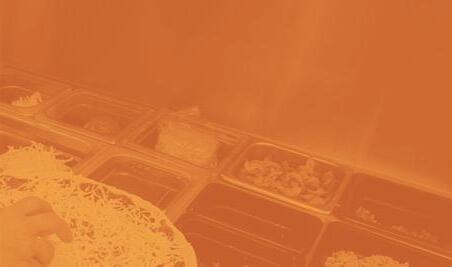



Supply has been, well, in short supply these days. The pandemic has created significant supply chain issues, and independent restaurant owners have had to bob and weave like Jack Dempsey in order to keep from getting knocked out.
Socially distant setups, coupled with major labor shortages on the manufacturing end, are causing widespread efficiency reduction, and that’s leading to product unavailability. “People don’t realize that, when workers can’t be in a manufacturing plant less than six feet from each other, that causes output to decrease significantly,” says Alyssa Fusco, Federal Hill Pizza’s territory manager at US Foods. “Another thing people don’t understand is that there are only a handful of key players in manufacturing. So when the Tyson trucks or the Brakebush trucks don’t show up, or the plants are having issues, that affects so many other branded products, because they’re all under the same house.
“It’s like a domino effect,” Fusco adds. “All of a sudden, a Tyson truck doesn’t show up, and we don’t have any more product to sell operators. They have to go to Brakebush. So now we have to go and wipe out another SKU, and then the process happens again and again, because there’s little to no forecasting, little to no communication. It’s like we’re at that part in the Titanic movie when the musicians are on the ship, playing the violins, while the ship is sinking, and Rose and Jack are running to the top of the ship to save themselves.”

Agreed. It’s glacier-level chaos out there. And with this kind of supply breakdown, restaurant operators have to make adjustments on their end to survive. They have to pivot. They have to be creative. They have to hire, train and retrain employees. They have to build better relationships with their suppliers and distributors just to stay afloat. As Fusco says, “If you’re not savvy and can’t think on your feet, you’re going to have problems.”
Here are four of my “bandages” for the cuts and gashes we’re getting each day as we try to run our business in this COVIDera world.
Nowadays, consistency in the restaurant game is out the window. We can’t rely on product being available on a regular basis from manufacturers. We just can’t. That means our customers can’t rely on product being available from us on a regular basis. My menu changes daily now— sometimes on the fly—based on what I can and can’t get.
The bad news: Having to change up the menu every day is a headache I don’t need. It’s like waking up every morning and having to write a new national anthem. I have enough on my mind. But it’s the only way I can stay in business in an industry that is perpetually in flux. Oh, say, can you see!
The good news: A changing daily menu can make your restaurant appear more upscale. It’s also a reason to pop on to social media and engage with your customers: “Hey, check out the special we’re having tonight!” Are you always looking for good content to post? A changing daily menu is the new social media influencer.
Having to change up the menu every day is a headache. It’s like waking up every morning and having to write a new national anthem. But a changing daily menu can also make your restaurant appear more upscale.
Mondako flour is milled from a blend of northern winter and spring wheat. Its consistent mixing time and water absorption is ensured by careful patent stream selection. This flour is well-suited for hand tossed and medium crust pizza applications. It is also chosen by bakers for its high tolerance with laminated and frozen baked goods.


Power flour is a premium, high-gluten flour milled from northern hard red spring wheat. Designed to produce baked goods that require long fermentation and retardation periods, Power is perfectly blended for pan and thick crust pizza formulas.


This 00-type flour is the key to producing a light dough with dependable extensibility, the perfect rise and a soft thin crust — all without compromising old world quality or flavor.
2UTILIZE RELIABLE PRODUCTS CONSISTENTLY AND WIDELY.
As a pizza restaurant operator, I know there are certain products that I can get consistently, such as flour. Since virtually all flour plants are automated and very few human beings are needed to work in them, we’re having an okay time getting flour in (even though shipping and receiving is going through the roof, but that’s another story). And when I know I can rely on a particular product, I try to use that product for all possible segments of my menu. For example:
Ricotta cheese Pizza, hamburgers, salads
Roasted red peppers Pizza, salads, new appetizers
Stale bread Croutons, bread crumbs
Ground beef Meatballs, pizza, salads, soups
Cherry tomatoes Salads (whole or ground), pastas, pizza (gourmet item)
Pepperoni Pasta dishes, salads, pizza
Romano cheese Romano potato chips, salads, pizzas
I have to be a chameleon. The current supply situation demands a level of creativity, which solves the problem of what my customers are going to eat tonight. However, it also brings its own set of problems. Because now I need somebody in my kitchen as either an executive chef or a sous chef to create these new dishes. So, yeah, I want to be flexible—I have to be flexible—but many times my staff looks at me like the proverbial deer in headlights when I tell them what I want to do. That means that, every day, I’m in the kitchen, training. And that costs time. And time is money. But I have to do it.
3UTILIZE UNRELIABLE PRODUCTS FOR PREMIUM DISHES ONLY—AND CHARGE CUSTOMERS ACCORDINGLY.
A 4- to 6-ounce white chicken breast has become the four-leaf clover of the pizza business—good luck finding one. That means I can no longer reliably offer pizza with white chicken breast on my menu at this point. Why? Because 1) I don’t have enough of it, and 2) I have to use that chicken breast, when I do get it, for dishes that have higher margins, like chicken Parm. I have to make it a premium item. As a replacement, I can buy chicken tenders, another type of white meat, to use for my chicken sandwiches. But, by and large, I have to say byebye to white chicken breast on pizza.

Fresh vegetables are also a concern. All those laborers toiling in the fields picking vegetables are really close and on top of each other, so vegetables have been difficult to order consistently.
And because of the scarcity of supply, I also have to increase pricing on these items. Luckily, our customers understand. They know that everything is going up—barbecue grills, fencing, lumber, fish—based on what they read in the newspapers and on social media. They are savvy and haven’t questioned our need to raise prices. At least, not yet.
When I know I can rely on a particular product, I try to use that product for all possible segments of my menu.
Relationships—with manufacturers, with distributors, with customers—are more important than ever. As Fusco notes, manufacturers haven’t been good about communicating delays and shortages to their distributor and retail partners. “They don’t want us to tell our customers that there are delays or shortages, because they don’t want our customers to go out and buy new product or find other things that fit their menu,” she says. “So it turns into a disaster from the top, and it’s just bleeding over, because there’s no communication to realistically stop it.”

Exactly. That’s why communication on our end is vital. We need to go to our sales reps and our manufacturer partners in order to build—and, in some cases, rebuild—that relationship. Let them know, “Hey, we’re here! And we’re doing everything we can to work with you.” We need to make the effort. Right now, manufacturing companies and distributors are going through their portfolios and deciding:
• Who is weathering this storm?
• Who has been loyal to my brand?
If the communication is bad, they’re kicking restaurants to the curb. No joke. I’ve seen it happen. And, in some cases, they’re doing it with less than 24 hours’ notice.

I don’t want that to be you. (Or me.) Do what you can. Change up your menu. Be creative with your dishes. Reach out to your distributors and manufacturers. Stay on top of food trends. At Federal Hill Pizza, we are problem-solving every day to weather this storm. We are battening down the hatches, tossing lifelines in the water, doing whatever we can to stay alive.
Just like Jack and Rose.

With the pandemic limiting dine-in options and a nationwide labor shortage crippling businesses, restaurant operators have been waking up to the wisdom of ghost kitchens, which allow for lower costs and smaller footprints through virtual storefronts. “One of the main drivers of the growth of the ghost kitchen market is the changing cost structures of the foodservice environment,” explains Michael Schaefer, global lead of food and beverage at Euromonitor, a global market research company with U.S. offices in Chicago. “Ghost kitchens push restaurant cost structures toward delivery rather than in-person dining, and the reduction of employees that comes with a delivery-focused model can grow thin margins and significantly bring down rent and staffing costs.”
The ghost kitchen trend kicked into overdrive with the pandemic. Experts weigh in on this movement—and how operators can make it work for them.





Now there’s a fresh, new way to stack up savings. Introducing Galbani Thin Sliced Fresh Mozzarella. With so many slices of creamy, all-natural, fior di latte Fresh Mozzarella in every log, you can top more sandwiches, pizzas, and appetizers at less cost per slice. Made in the USA by Italy’s #1 cheese brand, with no artificial whiteners, the milky flavor and soft texture make it easy to add Ispirazione Italiana to everything on your menu.




However, along with their many benefits, ghost kitchens also create unique challenges. How do you get the word out and win over customers without a physical location and the warmth of in-house hospitality? How do you stand out from the growing number of online competitors? How do you launch your brand if you’re working with a shoestring budget? Here, experts share their best advice on the potential and the pitfalls that surround ghost kitchens.








Megan Wintersteen, VP of marketing at Zenreach in San Francisco, notes that while ghost kitchens have been around for a number of years, their popularity skyrocketed during the pandemic, and those aftershocks will likely be felt for years. “We saw significant increases in delivery and takeout orders across 2020 and into 2021,” Wintersteen says. “Because humans are creatures of habit, we expect that new routines created during the pandemic will likely keep delivery rates higher than prepandemic levels as recovery continues.”
She points out several advantages to the ghost kitchen model: An operator requires less up-front investment in real estate, due to no dine-in, and in tangible items like menu printing, table settings and decor. “Operationally, ghost kitchens often allow food to be prepared more quickly and offer greater menu flexibility,” Wintersteen adds. “From a branding standpoint, ghost kitchens offer the ability to test a concept prior to making the larger investment of a dine-in establishment, and we’ve also seen examples of brands using ghost kitchens to evade poor reputations or reinvent themselves.”

“Ghost kitchens offer the ability to test a concept prior to making the larger investment of a dinein establishment, and we’ve also seen examples of brands using ghost kitchens to evade poor reputations or reinvent themselves.”
— MEGAN WINTERSTEEN, ZENREACHMASON ADAMS




Since modern-day trends can evolve literally by the minute, ghost kitchens mark an important shift in how consumers relate to food and the experience of eating, according to Miriam Aniel, head of content and research at Tastewise in Richmond, Virginia. “Through lower overhead costs and a delivery-only model, virtual restaurants are able to pivot quickly to address changing consumer tastes,” Aniel notes. “Is there a new dessert that customers are rumored to love? Add a creative version of it to the menu. Did that pizza topping fall flat? Take it off. Chefs in ghost kitchens are able to experiment with new ingredients and dishes with less risk of fallout than in traditional restaurants.”
Ghost kitchens can also cater to customers in thriving neighborhoods—without operators paying the high rents to score space there. “Virtual restaurants with expansive delivery options allow brands to rent kitchen space, often shared, in low-cost areas, slashing the costs of both the location and the support staff,” Aniel explains. “No customers dining in means no waiters, management, bussers, etc.”
Similarly, Bryan Cromwell, COO of Veneto Hospitality in Austin, Texas, which owns the ghost kitchen Benvolio’s, appreciates the ability to expand the reach of his business with delivery to new areas where people may know the brand but are reluctant to travel a long distance for it. Setting up a ghost kitchen allows him to test a new geographical market before launching a brick-and-mortar there.
Experts share quick tips for successful ghost kitchens.


“Bring the same customer attention to the online space that you would bring every day to a brick-and-mortar space. Engage with local events, partner with local online influencers, run Instagram contests—and really emphasize all of that in your online presence. Virtual restaurant owners who view their work not as transactional, but as relationship building, will have both loyal customers and a competitive edge.”
Miriam Aniel, head of content and research, Tastewise, Richmond, VA“Engage influencers and have lots of content to share. As you build, ask guests to leave good reviews, and answer any bad ones quickly. Working with third-party delivery, know the reputation of the companies you choose and how their drivers treat your products. Put in place measures such as safety seals, and be sure to use good takeout packaging that will hold up to transportation, hold in heat and make a good impression on the receiver. Treat all of the drivers you encounter with respect so they, in turn, will respect you and the product you serve.”
Bryan Cromwell, COO, Veneto Hospitality, Austin, TX“Invest in some merch so people can see your brand wherever they look. Start personally engaging with your audience: Use polls to let your following decide your newest specials or flavors. Ask for feedback, run ‘Ask Me Anything’ sessions, and DM your best customers and begin to build relationships with them. I even self-deliver on a designated day or set up pickup dates, because face time with your customers is clutch. You’re already a faceless entity, being cloud-based, so you need every opportunity you can get to personally connect with your customer and say, ‘Thank you for your support.’ Human connection goes a long way in this day and age.”
Ashley Burk, Steady Hand Cafe & Collective, Spring Lake, NJ


Though ghost kitchens offer myriad benefits, they still require basics associated with traditional restaurants. For example, Cromwell emphasizes that these kitchens, while less expensive, still have significant costs, including rent, advertising, and product and equipment purchases. What if you’re a newcomer starting on a shoestring budget? “You could identify someone currently in a kitchen but underutilizing it, and partner with them to launch,” Cromwell recommends. “Many ghost kitchens can support multiple concepts in a single kitchen, if the equipment and storage are compatible with your pizza concept.” For example, maybe someone in the area runs a breakfast operation that closes by afternoon, so you can run a pizza concept in the same space in evenings. “You would be able to cross-utilize cooler and counter space and perhaps only have to buy a pizza oven, reducing your cost and barrier to entry,” Cromwell says. “Then you split rent and fixed overhead costs, making it better for both parties.”

Indeed, Joey Simon, Senior Vice President of Operations of Miamibased Creating Culinary Communities (C3), notes that the pandemic exposed how grossly underutilized kitchen spaces are, especially in hotels and select-service restaurants. “Pre-pandemic, C3 observed most hotel kitchens were operating at just 15% to 20% efficiency—and these are kitchens in prime locations,” Simon says. “One idea is to

“We’re running three restaurants out of one shared kitchen, and customers can choose from all of them in one order.”
As a father of three, I’ve found the hardest things to teach are gratitude and work ethic.
Running a restaurant gives you a very unique way to teach both by example.
Some of the best operators, that I know, are always thanking their customers. We live in this crazy tech filled world but there is still nothing better then an old school, eye to eye, handshake with an “I truly appreciate you supporting me and my family. It means the world to me!”. Thank your customers. Thank your staff. Thank your food providers. Thank your FAMILY.
My longtime friend, Dustin Jones, of Simple Simon’s Pizza, in Tulsa, Ok, and I used to talk about “We don’t HAVE to go to work…. We GET to go to work!”. Showing your kids that you “Get To Go To Work” is huge.
Going to work isn’t a chore if you’re doing something you enjoy! When you have this attitude, your kids will see it.
Give thanks. Work hard. Love your family. Repeat.
To learn more about Perfect Crust’s pizza liners and other products, visit perfectcrust.com or email Eric Bam at Eric@perfectcrust.com

A Boston native now living in Tulsa, OK, Eric Bam is VP of sales and marketing for Perfect Crust, with 20 years of experience in the foodservice industry. A powerful force in the workplace, Bam uses his positive attitude and tireless energy to encourage others to work hard and succeed. He has three children and loves helping the men and women of the pizza industry grow their businesses.
run multiple brands out of a single kitchen and cross-train the same team to be able to cook cuisine from all concepts. This allows restaurants the ability to maximize operating efficiency, provide more robust customer-facing services, streamline internal services and maintain a low capital spend. As rents and labor become more expensive, the digital kitchen model offsets those costs.”
Therefore, Simon believes that finding a ghost kitchen space where other food brands or restaurants operate is key. A digital kitchen with six to eight brands operating out of a single space can generate a significant increase in revenue and has the potential to reach new demographics because of the increased diversity in options for customers.

Alternatively, ghost kitchens also allow a single operator to offer a variety of his own brands under one roof. That’s the route chosen by Gene McWilliams, owner of Kitchens Unlimited in Effingham, Illinois, which opened in November 2020 with three virtual concepts, including the pizza-focused Lucia’s Italian Kitchen. “While a lot of ghost kitchens are landlord-based—you may rent out 500 square feet and operate with third-party delivery—we own all of the restaurants and the delivery team; we don’t use third-party,” he explains. “We’re running three restaurants out of one shared kitchen, and customers can choose from all of them in one order.”
Because McWilliams wants to build more of a “chef-driven” brand, this format allows him to test the waters on new concepts—and, if one isn’t working, to change it on a moment’s notice. That said, even though ghost kitchens offer unique advantages, McWilliams stresses that many aspects are just as difficult as with brick-and-mortar operations—after all, you still need to master core aspects like marketing, accounting, menu items and overseeing staff.

“We post daily on social media, but Google is the most important. When people search for pizza near them, SEO is huge.”
— GENE MCWILLIAMS, KITCHENS UNLIMITED
















When you don’t have a storefront to entice customers—and potential patrons won’t be tempted by menu items traveling through the restaurant on the way to tables—having a strong digital presence is paramount. Wintersteen notes that third-party delivery services will be key in helping increase awareness for new operators. But, adds Michael Parlapiano, creative director of The Culinary Edge in San Francisco, exposure from third-party services will only go so far. “When people aren’t driving by your location, you have to approach your branding and marketing in a very serious way—it becomes more about search engine optimization and digital and social media strategies to connect with customers,” he says. “Just as people eat with their eyes first, the same goes for your brand: You need unique features to distinguish yourself from others. Create a cohesive esthetic in tone, name and design; have a strong sense of what your brand stands for and your values; and consider the ways to communicate that, from your photography to social media to packaging. Invest in your design to appeal to the specific customer you’re going after.” Then, as you build a loyal fan base, review that customer data to learn more about the people ordering from you and how you can better target them.
Wintersteen believes that improving your digital presence should involve a two-pronged approach: your owned channels (i.e., website and social media), which should reinforce the brand and provide customers with relevant information; and

third-party channels (your profiles across third-party delivery services, Google My Business, Yelp, etc.), which should be as simple and built-out as possible. “Using your website and social media to give the brand a personality, tout specials and promotions, and even provide a behind-the-scenes look at your operation are all ways to increase transparency with the customer,” Wintersteen says. “Fostering relationships with customers, without a dine-in experience, is much harder to achieve.” In addition, regardless of the length of your menu, Wintersteen suggests making it “digestible”—include topnotch visuals through photography and clear sections to make it easier to scan and order from.
Finally, keep in mind that in some areas, customers might not even know what ghost kitchens are all about. McWilliams, located in a rural town of 18,000, notes that there has been a learning curve with locals who are used to calling a pizzeria and asking about the day’s specials, versus ordering online and scrolling pics on social media. “We post daily on social media, like Facebook and Instagram, but really Google is the most important,” McWilliams says. “When people search for pizza or restaurants near them, SEO is huge. You want to pop up in those first couple of results. Ask your customers to review you on Google, not on Facebook. Photographs are huge, too— when people see mouthwatering images, they feel like they need to try you.”


Already
The Pizza Kitchen is open for business at PizzaTV.com with two new videos spotlighting innovative products from PMQ’s sponsors!

The




Kitchen: MFG Proofing Trays
From pizza to pretzels, from bagels to breads, MFG Tray has you covered with the perfect proofing board. Starting in 1952, MFG Tray has been making the tools pizza makers need to create the finest baked foods. In this video, PMQ’s Brian Hernandez tells you everything you need to know about MFG Tray’s long-lasting, sturdy and stackable proofing boards.
Watch
The Pizza Kitchen: The Cornhub Pizza featuring Melinda’s Hot Sauce

The Cornhub Pizza is the brainchild of Lee Hunzinger of Zoli’s Pizza in Fort Worth. It showcases a unique twist on a south-of-the-border staple—elote, or Mexican street corn. Featuring roasted corn, cotija cheese, mascarpone, cilantro, and a drizzle of Melinda’s Pizza Hot Sauce, this recipe captures the essence of a beloved Mexican comfort food—no passport required!
Watch the video at pizzatv.com/the-cornhub-pizza

Take these tips from innovative beverage experts to ensure your drinks menu pours forth some serious profits.
BY TRACY MORINJust when you thought you couldn’t stomach another pandemic-related aftershock, experts have observed that COVID-era customers expect more from restaurants today—and those expectations carry over to the beverage menu, too. “Customers are looking for an experience now, not just eating out,” asserts Shawn Soole, owner of Soole Hospitality Concepts in Victoria, British Columbia, Canada. “When you develop a creative drinks menu, it helps the guest venture outside of their normal choice—and, in turn, adds 5% to 10% or more in revenue.”
Now more than ever, consumers are in search of unique restaurant experiences they can’t recreate at home—and they’re more eager to explore different flavors or styles of drinks, says Kelly Hendriksen, director of beverage marketing for Atlanta-based Mellow Mushroom. “Americans are craving the innovative beverages they couldn’t get last year—uniquely crafted specialty drinks, both alcoholic and nonalcoholic, that are high-quality and reflect trend-forward ingredients,” she says. “Having a creative selection of beverages that continually introduces new items is essential to driving both guest trial and guest frequency. A signature beverage menu increases customer satisfaction (which enhances loyalty), grows top-line sales, and contributes significantly to profit margins.”
Soole emphasizes that the key to a great beverage menu is the why—the story behind how the drinks fit in with your concept. “We spend hours creating the ‘why’ behind the restaurant concept, but very rarely do drinks get the same love,” he says. “Start with what you’re trying to achieve with the beverage menu.” Hence, Soole’s top three pointers for a winning beverage program: Determine what you want from the program; ensure it’s easy to achieve during busy service times; and train the bar and floor staff to understand that every upsell equals a bigger tip. “Once you have the why, lay out the overall theme,” Soole

suggests. “How many nonalcoholic drinks or mocktails do you want, how many cocktails, highballs, etc.? Create a program that represents your venue but also the systems and setup you have.” In other words, don’t create a complicated cocktail program unless you have the skilled bartenders and bar design to pull it off on a busy night.
Also make sure you understand your market. If you’re just beginning, Soole recommends first focusing on classics— building guests’ confidence before creating a high-concept menu. “Focus your happy hour on drinks that build this confidence,” he suggests. “People are attracted to things they have heard of before, and having them on special makes the guest eager to try something that may be a house creation outside of happy hour.”
Hendriksen agrees that guests are looking for variety—but only after you earn their trust. “The key for guest trust (and ultimately loyalty) is ensuring that your core signature beverages are balanced and well-executed,” she says. “From there, knowing your consumer is crucial—their flavor preferences, whether they’re looking for a trusted brand or profile, where they are willing to explore and when they want to be in their comfort zone.”
Therefore, Hendriksen believes that every good cocktail program needs a healthy core of permanent menu items—guest favorites that are profitable, can be executed consistently, fit

“Focus your happy hour on drinks that build [guest] confidence. People are attracted to things they have heard of before, and having them on special makes the guest eager to try something that may be a house creation outside of happy hour.”
— SHAWN SOOLE, SOOLE HOSPITALITY CONCEPTSSGT. PEPPERONI’S PIZZA STORE














the brand, and feature ingredients that are appealing to the target audience. “From there, introducing variety through ongoing innovation keeps the menu fresh and exciting, and can generate new guests and drive guest frequency,” Hendriksen says.
Mellow Mushroom continues a “robust pipeline of innovation and testing” to help ensure that items are ready to roll out when customers are craving new flavors. “When we switch up our offerings is truly dependent on our guests,” Hendriksen says. “Limited-time features can earn their way onto the core menu if they generate a strong enough following.”
Whether you serve up nonalcoholic beverages only, offer wine and beer, or have a full-bar liquor license, a standout drinks menu should match the brand’s food menu. “Before creating a beverage menu, we do extensive market research to learn what is trending,” says Hector Godinez, culinary manager for Grimaldi’s Pizzeria, based in Scottsdale, Arizona. “We then consider what Grimaldi’s can bring to the table to get ahead of the identified trends. The menu is carefully crafted to complement our coal brick-oven pizza and calzones, as well as salads and desserts.”

For example, Grimaldi’s partnered with the Italian winery Mille Gradi to produce custom bottlings of Sangiovese and Pinot Grigio that are exclusive to the restaurant, providing a unique and authentic wine pairing for its cuisine. “Since our pizza is made using 100-year-old pizza making techniques, we also offer classic cocktails, such as an old-fashioned, martini, mule, and margarita, which pair well with our menu’s flavor profiles,” Godinez adds.

At V&M Italian-American Bistro in Wilmington, Delaware, co-owner Margherita Carrieri-Russo kicked off her strong cocktail menu with the Limoncello Ice Martini, which echoes the restaurant’s homemade-Italian focus with ingredients like in-house limoncello and lemon ice. And, as on the food menu, offering something for everyone was also important. “It was our goal to create a variety of drinks, with a variety of alcohols and local ingredients,” Carrieri-Russo explains. “We include vodka, tequila, gin, bourbon, whiskey, and something bubbly, like prosecco.”
To craft a beverage menu that stands out from competitors, Soole recommends exploring market trends in your region and understanding where you stand in that market. “Hard seltzers are extremely popular right now, but they’re just canned highballs, so create your own in-house versions,” Soole suggests. “Gin or vodka with housemade syrups and topped with club soda or flavored soda will give people an elevated experience, compared to a White Claw. Change your menu seasonally or every six months to leverage people’s changing tastes and the local selection of produce.”
Indeed, the Grimaldi’s beverage team thinks seasonally and/ or regionally to offer memorable flavors and tastes. “To create excitement and put our own Grimaldi’s signature on the menu, we put a twist on classic cocktails by adding Italian flavors like limoncello to our margarita and martini,” Godinez explains. “We
“Having a creative selection of beverages that continually introduces new items is essential to driving both guest trial and guest frequency.”
— KELLY HENDRIKSEN, MELLOW MUSHROOMMELLOW MUSHROOM GRIMALDI’S
add seasonal flavors, like watermelon, to our margarita during the summer, and Granny Smith apple and peach to our mule and sangria during the fall to take advantage of the freshness and quality of these seasonal ingredients.”
Carrieri-Russo agrees that working seasonally and locally allows mixologists to create authentic, one-of-a-kind flavors that keep customers coming back. “For holidays, we get eggnog from a local dairy farm—it’s fresh and out of this world,” she says. “We grow our own basil, which we can use in our peach-basil sangria, topped with prosecco. You get great quality when you stay close to home.”
At Mellow Mushroom, where the signature margarita has long been a guest favorite, staff members use this cocktail as a jumping-off point to create an entire menu category devoted to it. “We bring in different expressions of tequila to create varying flavor profiles that allow the guest to explore and find their favorite—whether Blanco, with its clean, fresh salinity; Reposado, with notes of caramel and vanilla; or Anejo, which is smooth and mellow,” Hendriksen says. “We’ve also brought a seasonal margarita into the mix as a limited-time offer this past summer, betting on trending flavors like smoky mezcal, sweet peach and spicy jalapeño. Different margaritas not only ensure that there’s something for a variety of palates, but also gives guests a reason to come back for that second (or third) cocktail.”
 V&M ITALIAN BISTRO
V&M ITALIAN BISTRO
You can also entice guests through smart pairing choices— which you may choose to call out on the menu or promote through server suggestion. Sgt. Pepperoni’s Pizza Store, with three locations in Orange County, California, features 16 taps in-house, including two wines, one hard seltzer and one nitro ale. “The beer lineup is IPA-forward, but with a well-balanced offering of lagers, pilsners and red ales—range is essential for pairing with pizza,” explains Shoe Schoemann, store manager at Sgt. Pepperoni’s Pizza Store. “In general, lighter beers pair with lighter pizzas. Ambers pair well with our Meatball Ricotta pizza. The nitro ale is ideal for a spicy pie like the Buffalo Chicken Pie, and we recommend Chardonnay on tap with the Margherita pizza.”
Moreover, Schoemann pays attention to detail and presentation. “Wherever it makes sense, we pair drinks with a garnish,” he says. “We serve Truly hard seltzer in a pint glass with a Tajin rim and lime wedge. And, because pizza brings people together—it’s a meal meant to be shared with friends and family—we offer pitchers of beer to extend the sharing culture of the pizza experience.”


V&M Bistro’s wine menu was also created to pair well with key flavors and categories across the menu, like tomato sauce, pizza, pastas and salads. “Our Pecorino salad with pear goes well with Sauvignon Blanc,” Carrieri-Russo says. “Chianti always goes well with Italian dishes, and a Pinot Noir or Argentinian Malbec pairs well with our chicken Parm.”
Finally, V&M has made the necessary adjustments to serve cocktails-to-go in the pandemic by pairing drinks with the right prep and packaging. First, Carrieri-Russo made sure that any to-go cocktails could travel well—for example, chilling the spirits themselves instead of adding ice—and created a menu of Boozy Ice Cream pints for to-go orders. “Just like with food, you have to know your drinks’ ingredients,” Carrieri-Russo concludes. “Then, really, it’s just a matter of having fun—there are no right or wrong answers.”
Tracy Morin is PMQ’s senior copy editor and the editor of PizzaVegan.com.
“We add seasonal flavors, like watermelon, to our margarita during the summer, and Granny Smith apple and peach to our mule and sangria during the fall to take advantage of the freshness and quality of these seasonal ingredients.”
— HECTOR GODINEZ, GRIMALDI’S PIZZERIA







Too many great ideas, visuals and details to share here. Get the whole picture at pmq.com/calendar
PMQ’s staffers review awesome products from two F&B industry events—the Nightclub & Bar Show and the Louisiana Restaurant Association (LRA) Showcase.




LINDA’S PICKS: NIGHTCLUB & BAR SHOW, LAS VEGAS

FRESH ORIGINS FARM
Fresh Origins Farm grows the very best microgreens, edible flowers and unique specialty items for every type of cuisine. There is no farm quite like it! They’re located in San Diego County, where the natural sunshine and wind produce flavorful, colorful, robust plants. With more than 500 varietals, from micro basils and petite parsleys to exotic leaves and micro flowers, there is something for everyone. Try their herb, fruit and flower crystals, too! freshorigins.com
Powers Paper is on a mission to provide products that will advance the restaurant and bar industry. I really liked the PowerNap Charging Solution napkin dispenser, which has a built-in phone charger that’s portable and rechargeable. Check out their washroom towel and tissue offerings, too. Based in northeast Wisconsin and offering products that are all made in the USA, they’re committed to enhancing your customer’s experience in a hygienic yet economical manner. powerspaper.com

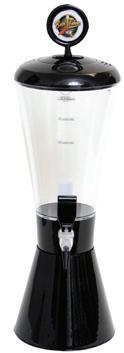
From hot to mild, Premier Proteins specializes in ultra-premium Berkshire sausage and bacon. They have full customization ability and can develop, tweak or build your perfect topping. You’ll immediately notice the quality difference in taste, texture and tenderness due to breeding—all animals are raised humanely on small family farms, with no antibiotics or hormones—and craft processing techniques. They also offer Wagyu beef, grass-fed Angus beef, and bison. premierproteins.com

Restaurant owners have been looking for more ways to incorporate reusable and unbreakable plastic drinkware. This is something that WonkyWare can provide! Their plastic drinkware, made in the USA from Tritan material, won’t chip, shatter or crack if dropped on a hard surface. They can also put logos on your drinkware for a great marketing message. If you’re looking to save money over time with a safer, more cost-effective and unbreakable product, their plastic drinkware is the right option for you. wonkyware.com



Rather than have your servers running single beers out to the tables, save time, sell more beer and excite customers with a self-serve Beer Tube. I liked their classic designs with a variety of finishes that match any theme or decor. Their patented sports designs are great for sports bars, pizzerias and restaurants. They also offer accessories, like cooling devices, cleaning items and lighted lids. They can add any logo or theme to the dispensers for enhanced visual power. Call and tell them you saw it in PMQ! beertubes.com

Your brick-oven pizza doesn’t deserve a brick-oven POS system. Arryved was founded by a couple of tech geeks who love craft beer (or are they beer geeks who love tech?). The system was developed for craft brewpubs and now serves dynamic F&B operations of all kinds, on-premise and online. Get online ordering, easy tab-splitting and tab-merging, and more pizza-centric tools. You can keep tabs open without holding cards and expedite your food service with easy modifiers and guest tracking. arryved.com/pizzerias

For just $1 a day, Cool-A-Zone’s evaporative coolers provide relief to customers and restaurant staff indoors and outdoors. Their CoolBox is not an air conditioner—it doesn’t contain any chemicals and doesn’t need to exhaust. The technology creates the effect you feel from a breeze passing through rain. Rain droplets draw in heat, and the resulting air feels cooler. Similarly, ambient air passes through the fan of the CoolBox and across the damp honeycomb pad, dropping the temperature by 10°F to 15°F. coolazone.com/PMQ


If you are in the restaurant industry, chances are you’ve heard of the late Chef Paul Prudhomme and Magic Seasoning Blends. But have you ever really looked at their line of seasonings? From Pizza & Pasta Magic and Magic Italian Seasoning to Vegetable Magic and Poultry Magic, they offer seasonings and marinades that give your pizzas, wings, pastas and other menu items that unique kick. Custom blends are one of their favorite challenges. They’re focused on creating flavors with an intense emphasis on taste. magicseasoningblends.com

Did you know there are thousands of dollars in rebates and discounts waiting for you on the equipment, ingredients and other items you already buy? Through Dining Alliance’s free program, pizzerias save on purchases without having to change what they buy or who they buy it from. Dining Alliance collects and organizes your purchasing data to uncover savings and brings together thousands of U.S. operators to help you pay less on your purchases. Operators that join Dining Alliance increase their margin by using their negotiated contracts and technology to make more informed business decisions. mydiningalliance.com

Kiosks can increase tickets up to 30% compared to counter/phone orders, prevent order entry mistakes that raise inventory costs, and control spiraling labor costs. PDQ’s custom-wrapped standalone/counter-mount devices are now enabled for tenders that include cash and cashless options (including a QR-code coupon scanner with validation) as well as buffet ordering and AI facial recognition. 877-968-6430, PDQPOS.COM

AM Manufacturing’s redesigned Atwood Round-O-Matic dough rounder reduces hours of handrounding dough. It rounds dough over a broad range of sizes, from one to 32 ounces, producing a round of unequaled quality. No adjustments are necessary for any size variation. The new rounder measures only 19” wide and takes up less room in busy and space-deprived kitchens. 833-241-5316, AMMFG.COM
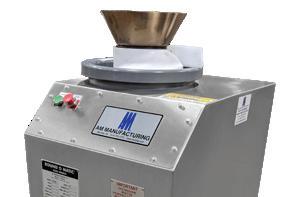



Dough Box Bags help you combat your labor shortage! Simply add a clean tray liner with each new batch of dough. If your dough boxes are not regularly cleaned between uses, bacteria and mold could begin to grow in your boxes. This can be a risk to your customers and to the quality of your dough. Dough Box Bags provide a quick solution to dirty dough boxes. DOUGHBOXBAG.COM

In addition to its standard offerings of advanced IP phone service and cellular backup Internet, PizzaCloud sets up pizzerias to allow a few staff members to take orders from home. With most POS systems, this can be done at virtually zero cost and helps address the problem of labor availability. PizzaCloud’s call center services also have people who can take phone calls and push orders into your POS system like web orders. 866-511-5521, PIZZACLOUD.NET

General Mills has been milling untreated flour since 1866. With a proven track record and nearly 30 bags to choose from, there’s no better partner for your clean-label creations. Ready to see what untreated flour can do for your pizza, baked goods and other bakery creations? Connect with General Mills’ team of expert sales representatives today. GENERALMILLSCF.COM
The pioneer of the cloud-native iPad transaction platform and POS, Revel Systems has native solutions for delivery, online and mobile ordering, drive-thru, loyalty, enterprise management, and more. Their cloud infrastructure allows for seamless integrations with third-party providers and open API for solutions tailored to your needs. As new trends and consumer expectations emerge, like self-service ordering and contactless payments, equip your pizzeria with a platform that quickly and easily adapts to your needs and scale. (415) 744-1433, REVELSYSTEMS.COM

Competitors must submit their best photos of a well plated, perfectly baked pizza, along with a picture of their beautiful faces cheesing it up for the camera by Sunday, October 31st .
The submissions will be judged by a panel of culinary and food photography experts. Winners will be announced LIVE on US Pizza Team’s Facebook, Tuesday, November 16th, 2PM CST , along with commentary by several judges on the winning submissions.
For more information about this event, rules or regulations, visit uspizzateam.com/ virtual2021/ , or contact Brian Hernandez at 662-234-5481 x129 or brian@pmq.com




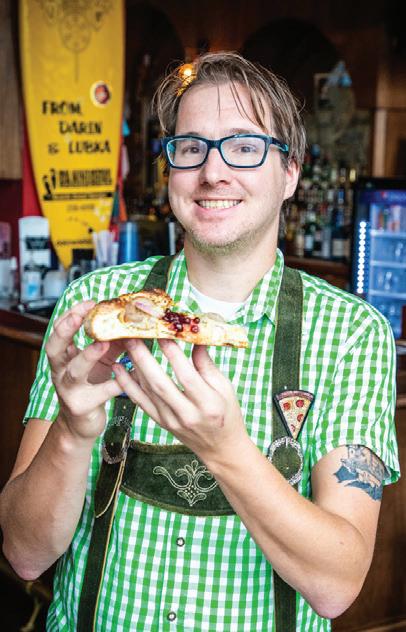


 2020 VUSPC: 1st Place - Lars Smith, State of Mind Public House & Pizzeria, Los Altos, CA.
2020 VUSPC: 2nd Place - Sean Dempsey, Dempsey’s Brewery Pub & Restaurant, Watertown, SD.
2020 VUSPC: 3rd Place - Rico Lunardi, Slice on Broadway, Pittsburgh, PA.
2020 VUSPC: 1st Place - Lars Smith, State of Mind Public House & Pizzeria, Los Altos, CA.
2020 VUSPC: 2nd Place - Sean Dempsey, Dempsey’s Brewery Pub & Restaurant, Watertown, SD.
2020 VUSPC: 3rd Place - Rico Lunardi, Slice on Broadway, Pittsburgh, PA.
















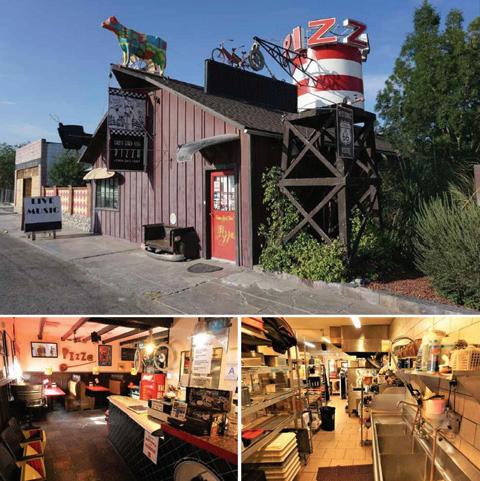







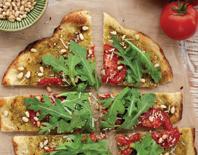






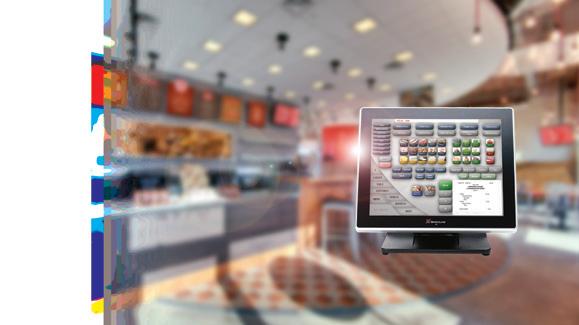










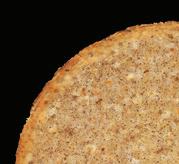








SINCE




















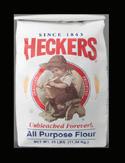














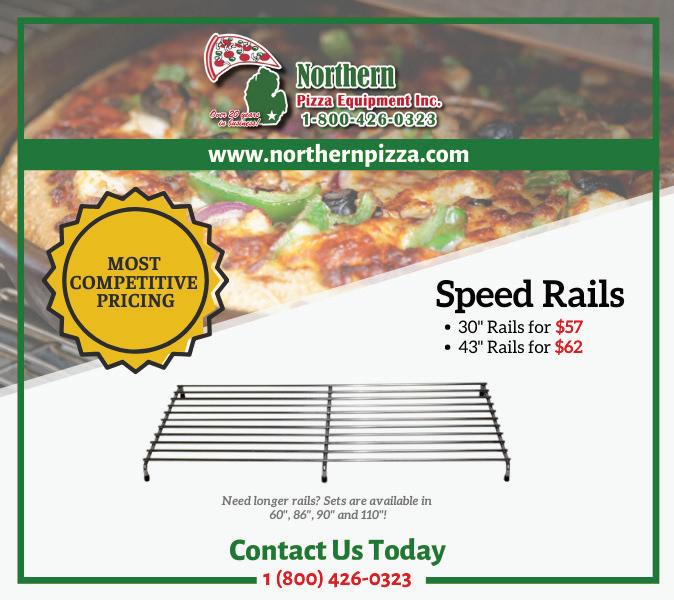












Best Choice Among Brand Name Mixers in the Market. HIGH QUALITY at a REASONABLE PRICE High Quality spiral and Planetary Mixers, Bread Slicers, Dough Sheeters, Meat Grinders, Dough Dividers/Rounders, Rotary Ovens and More! Only


Spiral Mixers Capacity from 88lbs to 440lbs of Dough


FOOD MACHINERY, INC. (PIZZA HUT OFFICAL VENDOR) 4602 Brass Way, Dallas, TX 75236

TEL: 214-331-3000; 866-7MIXERS; 866-875-6868; 866-451-1668



FAX: 214-331-3581; 972-274-5053

WEBSITE: www.thunderbirdfm.com; www.thunderbirdfm.net
PO Box 4768, Blaine, WA 98231
TEL: 360-366-0997; 360-366-9328
FAX: 360-366-0998; 604-576-8527

EMAIL: tbfm@tbfm.com; tbfmdallas@hotmail.com







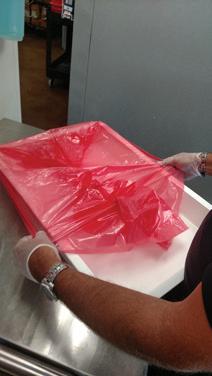

































The product of a mysterious illness and a nose-to-the-grindstone Greek immigrant, this Massachusetts pizzeria has thrived through three generations.
BY TRACY MORINNot much is known about the original founder of Village Pizza—only that his name was Teddy, and he’d traveled north from Pennsylvania to seek experimental treatment for his daughter, who had a rare illness. To fund the efforts, Teddy, who worked in a pizza shop, decided to open his own place in Greenfield, Massachusetts, called Village Pizza, in 1961. “He kept the place for three years, ended up leaving and sold it,” says current owner Chris Balis. “My father eventually bought it in 1974, and it’s been in the family ever since. Teddy had 120 pizza pans—we still use them today.”
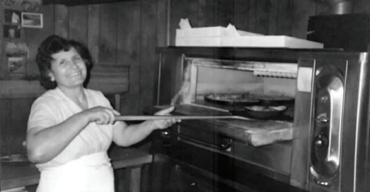


To say that Chris’ father, George, earned his success would be an understatement. A Greek immigrant with a third-grade education, he traveled to the States in 1966 to build a better life for his family, who stayed overseas until he could bring them over a decade later. George juggled gigs at Wonder Bread Co. and The Royal Typewriter Company, while working part-time at a nursing home and a pizza shop his brotherin-law owned. “He worked 112 hours a week for 20 years,” Chris recalls. “A Greek guy used to do accounting for Village Pizza, so he ran it by my father, and he ended up buying. There, he worked open to close, 10 a.m. to 2 a.m.—16 hours a day, seven days a week. I asked him once, ‘Why did you do that?’ He said, ‘Because I was afraid to fail.’”

Soon, though, the pizzeria became a full-family effort. When they arrived from Greece in ’76, George’s wife, Eleni, revamped a lot of the recipes, and the business started to really take off. Chris and his sister (now co-owner), Betty Gioules, worked in the business, as did his younger brother before eventually moving on. In 1988, George passed the pizzeria on to his kids; today, Chris’ wife and son, as well as Betty’s son, remain involved. His daughter helps out with social media—an area Chris finds a mystery but which, he notes, enables his customers to do the advertising for the pizzeria.

After 60 years, word-of-mouth is Village Pizza’s sole advertising strategy, and wait times often stretch well past the one-hour mark on weekends—a byproduct, Chris believes, of following his father’s original principles. “We do everything from scratch, and 65% to 70% of our business is pizza—that’s what we’re known for,” he says. “My father said you have to treat people the way you want to be treated. They work hard for their money, just like my father worked hard for his money. I just want to thank this country for the opportunity. I hope the next generation keeps it going for the next 60 years.”









